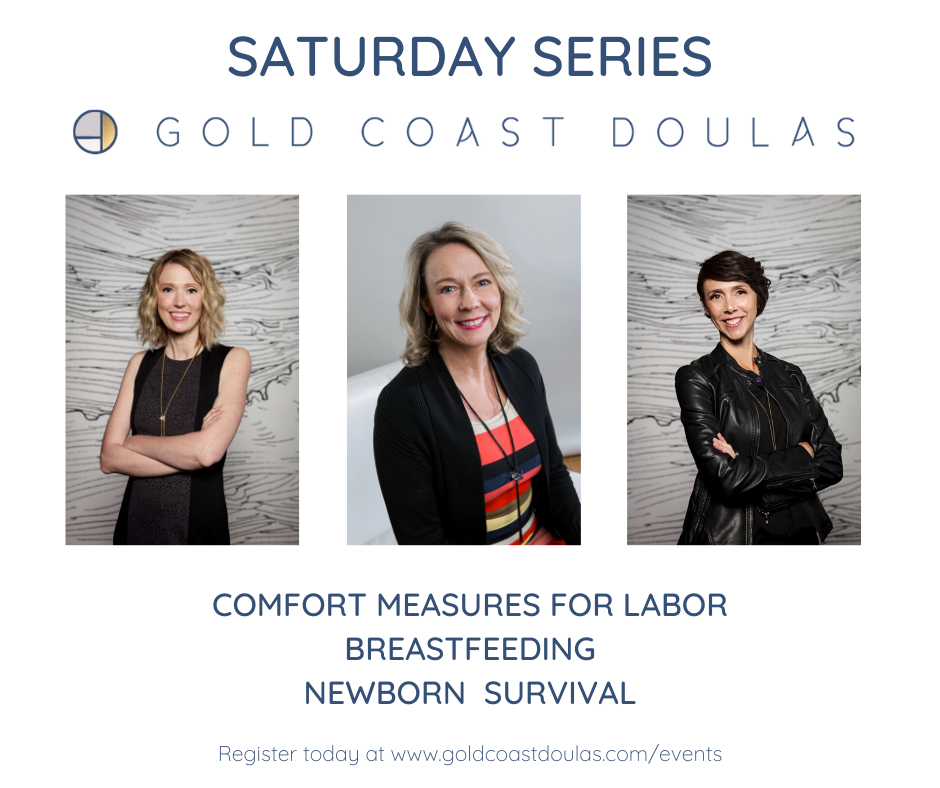
Gold Coast Doulas offers a Saturday Series of classes including Comfort Measures for Labor, Breastfeeding, and Newborn Survival. You can sign up for one, two, or all three classes.
Comfort Measures – 9:00am – 11:00am
Breastfeeding – Recorded to view anytime!
Newborn Survival – Recorded to view anytime!
Comfort Measures for Labor $90 – $125
This hands-on, in-person workshop, taught by Certified Birth & Postpartum Doula Kristin Revere, focuses on comfort measures for labor and birth. This class covers medical and non-medical pain relief options, communication, positions for labor and birthing, and breathing techniques. It will ease your mind as you prepare for birth.
This workshop is perfect for both first-time and seasoned parents. This class does not replace a comprehensive childbirth class. It will not cover stages of labor or interventions. This class includes worksheets.
This class has virtual ($90) or in-person private ($125) options.
Breastfeeding: Getting a Strong Start $90
This comprehensive virtual course is taught by Board Certified Lactation Consultant Kelly Wysocki-Emery.
Get access to the Breastfeeding: Getting A Strong Start course to watch on your own first…THEN get access to a virtual Q&A session to ask any lingering questions. This education is a hybrid model (some learning on your own via video course and then meeting with a lactation consultant to bring it all into focus).
What you get:
- 2 hours of up-to-date, solution-based breastfeeding video content culled from a lactation consultant working in the field for nearly 30 years
- Access to video content for as many babies as you have (forever)
- Access to one free, live virtual Q&A with an IBCLC (Internationally Board-Certified Lactation Consultant) to answer any lingering questions
- We will cover everything and still leave time for pumping/work/bottle questions. Having your partner in crime join is highly recommended, as they will be a crucial part of the teamwork needed to breastfeed.
Newborn Survival $90
Learn how to survive your first several weeks home with baby! In this laid-back class, you will go over real-life scenarios so that you’re confident and prepared when your baby arrives. Your instructor, Alyssa Veneklase, is a Certified Postpartum Doula, Newborn Care Specialist, and Certified Infant & Child Sleep Consultant. She will answer common questions about feeding, fussiness, soothing techniques, swaddling methods, bathing, safety, sleeping, and more.
She wants parents to know they’re fully capable of doing this, they just need to know what to expect ahead of time. You’ve got this!
This class is part of our Saturday Series, but is not offered live. A recorded version of the class will be emailed to you, along with the worksheets, that can be completed by the student at any time. Alyssa offers a scheduled live 30 minute call to answer questions.
Each virtual class is $90. Remember, you can register for one, two, or all three! If you decide later to attend another class, you can sign up the day of (as long as the class is not full). To register just fill out the registration form on the website and let us know which class date you’re interested in.
Comfort Measures requires a minimum of 2 registrations. Students will be notified if a class is cancelled.
We accept most HSA and FSA accounts for the classes.
Saturday Series
- (616) 294-0207
- info@goldcoastdoulas.com
-
1430 Robinson Road SE, Suite 204,
Grand Rapids, MI 49506
